Gin Essential Info
- Color: Clear
- Region: Produced heavily in the U.K. but can be produced anywhere, historically from Holland; only 13 gins have “geographical indications”
- ABV: Minimum 40% ABV
- Aged: Possibly, 3 to 6 months if desired, but not necessary
- Made from: Usually a grain mash (could be barley or corn), can be made from any mash to produce a neutral spirit that’s then infused with botanicals including juniper
- Commercial Examples: Bombay Sapphire, Tanqueray, Ransom (Old Tom), Plymouth Gin, Berkshire Mountain Distiller’s Greylock Gin (U.S.), Dorothy Parker (U.S.)
- Popular Cocktails: Gin Martini, Gin Gimlet, Gin & Tonic, Negroni, Tom Collins, The Last Word
The eternal quandary for some people might be Vodka or Gin Martini? (Actually, most people land vehemently on one side of the debate or the other.) Truth is, but for one essential step, vodka and gin would be very much the same thing. Thankfully—for all gin lovers out there (and their numbers are growing)—that step turns gin into something entirely unique.
Like vodka, gin is column-distilled (the efficient distillation method innovation by Robert Stein and Aeneas Coffey, respectively, basically allowing for continuous stripping of alcohol from water, and the loss of a lot of flavoring congeners). Unlike vodka, though, gin is distilled (or redistilled) with a very unique blend of botanicals and ingredients, resulting in a spirit that has intentional flavor, where vodka has next to none.
Not only are these flavors unique, they’re assertive. Whatever blend of botanicals and spices go into a gin, you’ll always find some more or less prominent expression of juniper. And if you’ve never had juniper, just imagine drinking a Christmas tree (or Chanukah bush, or non-denominational holiday pine plant). Not that’s it’s quite so simple; juniper actually packs a pleasant, floral, and, yes, assertively woodsy, piney flavor. The reason gins contain juniper goes back to Genever, gin’s great, funky granddaddy, a malt barley wine-based spirit that was meant to have medicinal properties but tasted pretty rough. (Juniper was added to mask the bad flavor, though modern Genevers are all about creating a beautiful, more or less pronounced ballet of sorts between malt and juniper notes).
Genever continues to this day, but an offshoot—gin—left the malt barley wine behind and kept on with the juniper, though gins hardly stop there. Not only is there a solid variety of gin styles (see below), but within those styles, gin producers may use a vastly different variety and proportion of botanicals, spices, and fruits to give gin its final bouquet—anything from citrus (a favorite) to florals, spices, black pepper, herbs, cucumber, etc. The end result is a spirit that can drink respectably on its own but also lends a garden’s worth of flavor to cocktails.
Here, a brief primer on the basic gin styles. Worth trying, ideally at a bar (so you don’t have to buy separate bottles) :
- “London Dry” is the name of a traditionally dry (as in not at all sweet) kind of gin (often produced in the U.K.), popular for cocktails.
- “Plymouth Gin” actually must be made in Plymouth, England, and tends to have a slightly earthier flavor profile due to more roots in the mixture of flavoring botanicals.
- “Old Tom” gin is a recent resurrection of an old style that’s historically a little sweeter (like Genever) without being as full-bodied as Genever.
- “Navy Strength” gin is characterized by an exceptionally high proof—57% ABV and above
- American craft distilleries are expanding on the basic definitions of gin with new bottlings.
